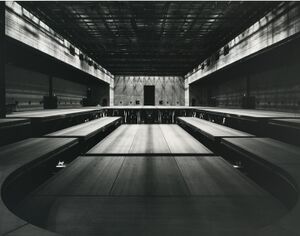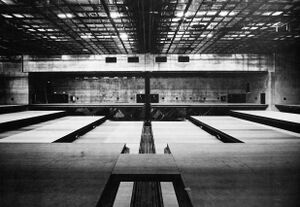In the inter-war period, the theatrical avant-gardes felt the need for a theatre that would allow them to carry out their proposed innovations. The empty space, with only walls, floor and ceiling, became the model for black-box and flexible theatres.
Edward Gordon Craig wrote in 1922: A necessity appeared to me: the theatre must be an ‘empty space’ with only a ceiling, a floor, and walls; within this space, a new kind of temporary stage and auditorium must be built for each new play. In this way we will discover new theatres, because each type of drama demands a special type of stage. (Q325)
The theatre of the 1960s renewed the desire of the avant-garde to escape from the Italian model, which was too limiting, too codified and representative of an aesthetic from which they wanted to break away. In the same spirit as Gordon Craig, it was advocated that the theatre space should not pre-establish or condition any spatial solution, but should leave the field free to all investigations. Each show must impose its own scenography, its own form, its own space, and establish a unique relationship between actors and spectators. Each show needs a transformable container, technically equipped – a ‘black box’, adaptable to any need of the director.
The small black-box studio became established for experimental and fringe work, and for training purposes, from the school drama studio to the technical laboratory. In the UK regional theatre building boom of the 1960s and 1970s, the black box studio was an essential adjunct to the more traditional ‘main house’ theatre. In 1976 at the new National Theatre in London (Q9343), the amphitheatre Olivier and the proscenium-arch Lyttelton were joined, as an afterthought, by the flexible, courtyard-like Cottesloe (now called the Dorfman). Many would claim this third auditorium is the most successful of the three.
However, the flexible, black-box concept brings difficulties as well as opportunities. If every production must create a new scenography within the empty container, then every production must have the technical, financial, creative and human resources required to fill it, otherwise a minimal production becomes an empty production, devoid of life and warmth.
Not all flexible spaces are black boxes. The Schaubühne (Q13102) was born in West Berlin in 1981 with all the ingredients to become a model theatre machine. Located in a central area of the city, it occupies a well-known work of modern architecture: The Schaubühne am Lehniner Platz is part of the Woga complex planned by Berlin architect Erich Mendelsohn in 1926-28, in a space originally built as the Universum Cinema.
The new house is the largest spoken theatre in western Berlin, intended to overcome the supposed limitations of the company’s previous ramshackle home in Hallesches Ufer, where the company had established itself in 1962. There, the group had made a name for itself. On 18 November 1970, with the staging of The Mother, Bertolt Brecht’s adaptation of Maxim Gorki's novel, the Schaubühne had begun a new phase under the direction of Peter Stein (Q30555). Inspiration was to be taken from previous productions: from Ibsen’s Peer Gynt (1971), a hilly topography with the audience situated on the two long sides of the nave. From Übungen für Schauspieler (Exercises for Comedians, 1974), and from Euripides’ The Bacchae (1974), unique, distressing spaces: the former because of its mysterious luminosity and the strange sensation of the asbestos-clad walls, the latter because it is too cold. From Gorki's The Holidaymakers (1974), a real forest. Any work offered the opportunity to transform the space of the theatre.
In the new premises, the machines installed on the roof and in the basement were to be the means to achieve these transformations more easily and more completely. This was to be the multi-purpose theatre, divisible into rooms of varying dimensions, in a display of mechanisation unusual in the group’s practice before then. However, as the years went by, the mobile multi-purpose rooms tended to become fixed, and the structures of the audience seating were built over the mechanisms that should have transformed the floor.
In theory, Schaubühne had not appealed to the machine as a sign of fidelity to the spirit of modern times. Advanced technology was only to be used to achieve greater creative freedom. Experience has shown that this confidence was unjustified. Due to financial constraints, the many possible configurations are not being used, and today the three separate auditoria are played individually in isolation and do not change. The lifts that reconfigure the many modules of the floor are out of use. Nevertheless, the possibilities of a grand vision in theatre architecture and performance show the limits we can attempt to exceed.



